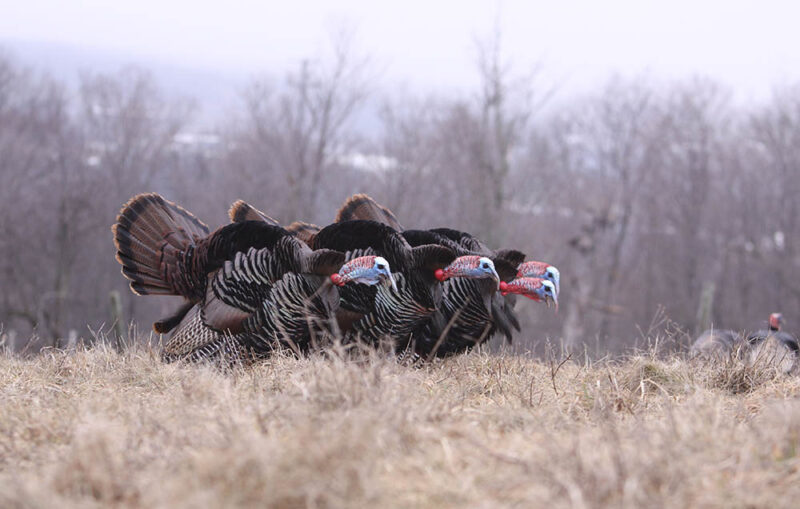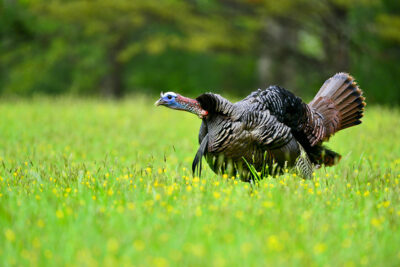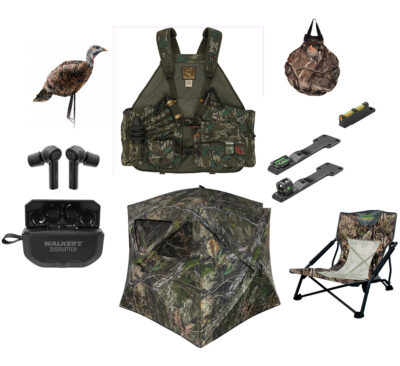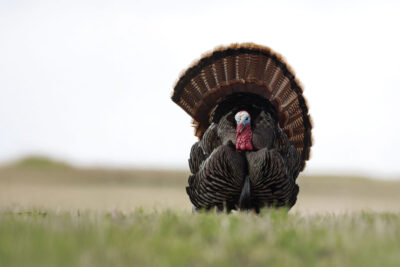By Paul Rackley, GunBroker Editor

There was a meme a while back of Kermit the Frog staring outside in the rain with the words, “I know on the outside I look fine, but deep down I need to hear one gobble.” That’s pretty much how I feel most of the year. I love turkey hunting and look forward every year to chasing birds with my Remington 870 during the early season.
Of course, early season turkey hunting isn’t the easiest of activities. This is because all kinds of factors affect turkey hunting. These include male/female ratio, hunting pressure, temperature and length of day, especially length of day, according to Mark Hatfield, National Wild Turkey Federation National Director of Science and Planning.
“The primary driver of behavior in the spring is the amount of daylight,” Hatfield said. “It is the photo period. Temperature moves the needle, but it is not the driving force.”
Coming out of winter into the early spring, both sexes of turkeys are usually flocked together. The females are worried about food while the males are establishing structure — the pecking order.
As flocks break up, males typically continue the structure. Hens, on the other hand, get looser, starting to prepare for the upcoming nesting season. Hens are getting ready to nest; toms are establishing dominance for breeding. As such, toms are gobbling a lot, creating one of the biggest arguments in turkey hunting — when the turkey season should start.
Setting of the Season
Some hunters want to move up turkey seasons to correlate with early gobbling. Some years, toms gobble hard in January, February and March, but seem to drop off in April and May during the season. This frustrates hunters, making them think that seasons are set too late.
Hatfield points out, however, that early gobbling has nothing to do with mating. Nor does gobbling early make birds “gobbled out” later in the year. In fact, most of this early gobbling happens when birds are in winter flocks of both toms and hens. There is zero breeding happening.
“Early gobbling has to do with establishing dominance among males, not breeding,’ said Hatfield. “We need the birds to go through the dominance structure.”
As breeding begins, toms are with hens. They don’t gobble as much because they don’t have to gobble. As hens become bred, they start to break off to build nests and lay eggs. Birds do, however, gather back together to roost. This happens over time, a few weeks or more, until more hens are bred than are not bred. This is when toms get active again, trying to find more hens to breed. It is also the time when biologists aim to hit with turkey seasons.
“We want to set a season where at least 50 percent of hens are laying or sitting on the nest,” said Hatfield. “This ensures the future of the species, and it provides the best opportunities for hunters to take birds. The simple fact is that turkeys don’t get gobbled out.”
The factors affecting gobbling during hunting season include number of bred hens, length of daylight and hunting pressure. As more hens get bred and days get longer, toms get more active. However, as hunters push birds harder, toms get smarter and more wary of calls. This has nothing to do with time of year and everything to do with strategy and tactics, of which many hunters have little.
Early Season Turkey Hunting Tactics
There is just something about calling a hot bird into range. It is one of the main reasons why turkey hunting is so popular. However, it doesn’t always work that way, especially in heavily pressured areas.
For this reason, Hatfield recommends patience in the early season. Turkey seasons are set up to have most of the hens bred and nesting. So, even though toms might have hens by their sides in the morning, those hens will often slip off as the day progresses. Hunters who can stick around and slow down have greater chances of success.
This can be especially true before the spring green up, when the woods are wide open. Turkeys have excellent eyesight, so it is easy to bump birds without even knowing the birds are nearby. Hunters need to stay still, tone down calling and be patient to be successful on quiet birds when early season turkey hunting. Here are a few other tips to bring birds into range of HEVI-Shot or Federal TSS turkey loads.
Food & Sleep
There are lots of places where people have to choose between desires, such as good or bad and money or guns. Luckily for turkey hunters, we can combine food and sleep. Not for ourselves, of course, but for the turkeys. During the early season, males are concerned about fighting and hens. Hens are smarter as they are only concerned about food and sleep.
If birds aren’t responding, consider setting up between roosts and food sources. The hens are going to fly down, gather up and slowly head toward where they’re going to feed. And the toms are going to follow. This might be a good time to use a blind, because that many eyes can be pretty observant.
You Can Be Tardy?
It seems counterproductive but hunting later in the day can be quite successful. And this can be done in a couple of way. First, hunters can just keep hunting, if legal. There is nothing wrong with trying to get a bird off the roost and sticking around if unsuccessful.
If toms gobble on the roost but shut up after hitting the ground, it typically means they have hens. Eventually, hens start slipping away, leaving an interested tom alone. Setting up in a likely area and making soft calls every so often can equal success. Stay alert, though, because toms can come in hot or silent.
Hunters can also head out to hunt after most others have called it a day. As long as it is legal, it doesn’t matter if it is late morning or early afternoon. The moment hens sneak away, toms start looking to find another. Locator calls really help determine if a bird is nearby.
Change It Up
It is weird how a call works one day but can’t strike up anything the next. In fact, birds can be hot on a specific pot and peg call on the roost and lose interest the moment feet hit the ground. No one truly understands why this happens, but it is a good argument for having options.
Hunters should carry a variety of turkey calls, from box calls to pot and peg and mouth diaphragm. Keep in mind that not many hunters use wingbone or tube calls, so turkeys don’t hear these much.
It can also be a good idea to change locations, as turkeys, both toms and hens, don’t typically stand still. Turkeys constantly move, whether feeding or looking for other birds. Shifting 100 yards or so, especially if changing calls, can change the game. Just be careful to not to be seen by the tom in the bare woods of early season turkey hunting.
Talk to the Flock (Boss Hen)
Quite often during the early season, toms respond well to calling. However, they aren’t going to leave a whole bunch of hens just to find one. Hunters can, however, call to the whole flock, which can bring a gobbler, or gobblers, in tow. This entails feeding clucks and purrs, along with the occasional kee kee. This really works well if hunting between roost and food.
Something along the same lines involves calling to the boss hen. There is always one hen that leads the flock. She is in charge of the hens, jakes and jennies, which means she is in charge of everything. Hunters can irritate that boss hen by imitating her. If she yelps three times and follows it up with a cluck, do the same immediately after her. Get loud if she gets loud. The more she calls, the better chance she will head over to run off the upstart. Just be sure to ease up as the flock gets closer.
Sound Off Like a Tom
A lot of the gobbles folks hear when early season turkey hunting are focused on dominance, not breeding. Because of this gobbling at toms can goad the big man into looking for a fight. Just be sure to pay attention to what is in the area. Other hunters might lock in on the fake gobbles and try to stalk that lone tom he or she hears.
Related Article: 7 Tactics to Get Around a Silent Spring
Related Article: Mossberg 500 Turkey Holosun Micro Dot Combo





